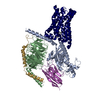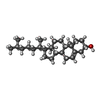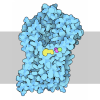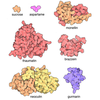+ Open data
Open data
- Basic information
Basic information
| Entry | Database: PDB / ID: 8smv | ||||||
|---|---|---|---|---|---|---|---|
| Title | GPR161 Gs heterotrimer | ||||||
 Components Components |
| ||||||
 Keywords Keywords | MEMBRANE PROTEIN / GPCR / orphan / active / Hedgehog | ||||||
| Function / homology |  Function and homology information Function and homology informationnegative regulation of smoothened signaling pathway involved in dorsal/ventral neural tube patterning / ciliary membrane / PKA activation in glucagon signalling / developmental growth / hair follicle placode formation / D1 dopamine receptor binding / intracellular transport / vascular endothelial cell response to laminar fluid shear stress / renal water homeostasis / activation of adenylate cyclase activity ...negative regulation of smoothened signaling pathway involved in dorsal/ventral neural tube patterning / ciliary membrane / PKA activation in glucagon signalling / developmental growth / hair follicle placode formation / D1 dopamine receptor binding / intracellular transport / vascular endothelial cell response to laminar fluid shear stress / renal water homeostasis / activation of adenylate cyclase activity / Hedgehog 'off' state / adenylate cyclase-activating adrenergic receptor signaling pathway / cellular response to glucagon stimulus / regulation of insulin secretion / adenylate cyclase activator activity / trans-Golgi network membrane / negative regulation of inflammatory response to antigenic stimulus / Hedgehog 'on' state / G protein-coupled receptor activity / bone development / recycling endosome / platelet aggregation / G-protein beta/gamma-subunit complex binding / cognition / Olfactory Signaling Pathway / Activation of the phototransduction cascade / adenylate cyclase-activating G protein-coupled receptor signaling pathway / G beta:gamma signalling through PLC beta / Presynaptic function of Kainate receptors / Thromboxane signalling through TP receptor / G protein-coupled acetylcholine receptor signaling pathway / Activation of G protein gated Potassium channels / Inhibition of voltage gated Ca2+ channels via Gbeta/gamma subunits / G-protein activation / Prostacyclin signalling through prostacyclin receptor / G beta:gamma signalling through CDC42 / Glucagon signaling in metabolic regulation / G beta:gamma signalling through BTK / Synthesis, secretion, and inactivation of Glucagon-like Peptide-1 (GLP-1) / ADP signalling through P2Y purinoceptor 12 / photoreceptor disc membrane / Sensory perception of sweet, bitter, and umami (glutamate) taste / Glucagon-type ligand receptors / Adrenaline,noradrenaline inhibits insulin secretion / endocytic vesicle membrane / Vasopressin regulates renal water homeostasis via Aquaporins / Glucagon-like Peptide-1 (GLP1) regulates insulin secretion / G alpha (z) signalling events / sensory perception of smell / cellular response to catecholamine stimulus / ADORA2B mediated anti-inflammatory cytokines production / ADP signalling through P2Y purinoceptor 1 / G beta:gamma signalling through PI3Kgamma / adenylate cyclase-activating dopamine receptor signaling pathway / Cooperation of PDCL (PhLP1) and TRiC/CCT in G-protein beta folding / GPER1 signaling / Inactivation, recovery and regulation of the phototransduction cascade / cellular response to prostaglandin E stimulus / G-protein beta-subunit binding / heterotrimeric G-protein complex / G alpha (12/13) signalling events / sensory perception of taste / extracellular vesicle / signaling receptor complex adaptor activity / Thrombin signalling through proteinase activated receptors (PARs) / positive regulation of cold-induced thermogenesis / retina development in camera-type eye / G protein activity / GTPase binding / Ca2+ pathway / fibroblast proliferation / High laminar flow shear stress activates signaling by PIEZO1 and PECAM1:CDH5:KDR in endothelial cells / G alpha (i) signalling events / G alpha (s) signalling events / phospholipase C-activating G protein-coupled receptor signaling pathway / G alpha (q) signalling events / Hydrolases; Acting on acid anhydrides; Acting on GTP to facilitate cellular and subcellular movement / Ras protein signal transduction / Extra-nuclear estrogen signaling / cell population proliferation / cilium / G protein-coupled receptor signaling pathway / lysosomal membrane / GTPase activity / synapse / GTP binding / protein-containing complex binding / signal transduction / extracellular exosome / metal ion binding / membrane / plasma membrane / cytoplasm / cytosol Similarity search - Function | ||||||
| Biological species |  Homo sapiens (human) Homo sapiens (human) | ||||||
| Method | ELECTRON MICROSCOPY / single particle reconstruction / cryo EM / Resolution: 2.74 Å | ||||||
 Authors Authors | Hoppe, N. / Manglik, A. / Harrison, S. | ||||||
| Funding support |  United States, 1items United States, 1items
| ||||||
 Citation Citation |  Journal: Nat Struct Mol Biol / Year: 2024 Journal: Nat Struct Mol Biol / Year: 2024Title: GPR161 structure uncovers the redundant role of sterol-regulated ciliary cAMP signaling in the Hedgehog pathway. Authors: Nicholas Hoppe / Simone Harrison / Sun-Hee Hwang / Ziwei Chen / Masha Karelina / Ishan Deshpande / Carl-Mikael Suomivuori / Vivek R Palicharla / Samuel P Berry / Philipp Tschaikner / Dominik ...Authors: Nicholas Hoppe / Simone Harrison / Sun-Hee Hwang / Ziwei Chen / Masha Karelina / Ishan Deshpande / Carl-Mikael Suomivuori / Vivek R Palicharla / Samuel P Berry / Philipp Tschaikner / Dominik Regele / Douglas F Covey / Eduard Stefan / Debora S Marks / Jeremy F Reiter / Ron O Dror / Alex S Evers / Saikat Mukhopadhyay / Aashish Manglik /   Abstract: The orphan G protein-coupled receptor (GPCR) GPR161 plays a central role in development by suppressing Hedgehog signaling. The fundamental basis of how GPR161 is activated remains unclear. Here, we ...The orphan G protein-coupled receptor (GPCR) GPR161 plays a central role in development by suppressing Hedgehog signaling. The fundamental basis of how GPR161 is activated remains unclear. Here, we determined a cryogenic-electron microscopy structure of active human GPR161 bound to heterotrimeric G. This structure revealed an extracellular loop 2 that occupies the canonical GPCR orthosteric ligand pocket. Furthermore, a sterol that binds adjacent to transmembrane helices 6 and 7 stabilizes a GPR161 conformation required for G coupling. Mutations that prevent sterol binding to GPR161 suppress G-mediated signaling. These mutants retain the ability to suppress GLI2 transcription factor accumulation in primary cilia, a key function of ciliary GPR161. By contrast, a protein kinase A-binding site in the GPR161 C terminus is critical in suppressing GLI2 ciliary accumulation. Our work highlights how structural features of GPR161 interface with the Hedgehog pathway and sets a foundation to understand the role of GPR161 function in other signaling pathways. #1: Journal: bioRxiv / Year: 2023 Title: GPR161 structure uncovers the redundant role of sterol-regulated ciliary cAMP signaling in the Hedgehog pathway. Authors: Nicholas Hoppe / Simone Harrison / Sun-Hee Hwang / Ziwei Chen / Masha Karelina / Ishan Deshpande / Carl-Mikael Suomivuori / Vivek R Palicharla / Samuel P Berry / Philipp Tschaikner / Dominik ...Authors: Nicholas Hoppe / Simone Harrison / Sun-Hee Hwang / Ziwei Chen / Masha Karelina / Ishan Deshpande / Carl-Mikael Suomivuori / Vivek R Palicharla / Samuel P Berry / Philipp Tschaikner / Dominik Regele / Douglas F Covey / Eduard Stefan / Debora S Marks / Jeremy Reiter / Ron O Dror / Alex S Evers / Saikat Mukhopadhyay / Aashish Manglik /   Abstract: The orphan G protein-coupled receptor (GPCR) GPR161 is enriched in primary cilia, where it plays a central role in suppressing Hedgehog signaling. GPR161 mutations lead to developmental defects and ...The orphan G protein-coupled receptor (GPCR) GPR161 is enriched in primary cilia, where it plays a central role in suppressing Hedgehog signaling. GPR161 mutations lead to developmental defects and cancers. The fundamental basis of how GPR161 is activated, including potential endogenous activators and pathway-relevant signal transducers, remains unclear. To elucidate GPR161 function, we determined a cryogenic-electron microscopy structure of active GPR161 bound to the heterotrimeric G protein complex G. This structure revealed an extracellular loop 2 that occupies the canonical GPCR orthosteric ligand pocket. Furthermore, we identify a sterol that binds to a conserved extrahelical site adjacent to transmembrane helices 6 and 7 and stabilizes a GPR161 conformation required for G coupling. Mutations that prevent sterol binding to GPR161 suppress cAMP pathway activation. Surprisingly, these mutants retain the ability to suppress GLI2 transcription factor accumulation in cilia, a key function of ciliary GPR161 in Hedgehog pathway suppression. By contrast, a protein kinase A-binding site in the GPR161 C-terminus is critical in suppressing GLI2 ciliary accumulation. Our work highlights how unique structural features of GPR161 interface with the Hedgehog pathway and sets a foundation to understand the broader role of GPR161 function in other signaling pathways. #2:  Journal: Nat Struct Mol Biol / Year: 2024 Journal: Nat Struct Mol Biol / Year: 2024Title: GPR161 structure uncovers the redundant role of sterol-regulated ciliary cAMP signaling in the Hedgehog pathway. Authors: Nicholas Hoppe / Simone Harrison / Sun-Hee Hwang / Ziwei Chen / Masha Karelina / Ishan Deshpande / Carl-Mikael Suomivuori / Vivek R Palicharla / Samuel P Berry / Philipp Tschaikner / Dominik ...Authors: Nicholas Hoppe / Simone Harrison / Sun-Hee Hwang / Ziwei Chen / Masha Karelina / Ishan Deshpande / Carl-Mikael Suomivuori / Vivek R Palicharla / Samuel P Berry / Philipp Tschaikner / Dominik Regele / Douglas F Covey / Eduard Stefan / Debora S Marks / Jeremy F Reiter / Ron O Dror / Alex S Evers / Saikat Mukhopadhyay / Aashish Manglik /   Abstract: The orphan G protein-coupled receptor (GPCR) GPR161 plays a central role in development by suppressing Hedgehog signaling. The fundamental basis of how GPR161 is activated remains unclear. Here, we ...The orphan G protein-coupled receptor (GPCR) GPR161 plays a central role in development by suppressing Hedgehog signaling. The fundamental basis of how GPR161 is activated remains unclear. Here, we determined a cryogenic-electron microscopy structure of active human GPR161 bound to heterotrimeric G. This structure revealed an extracellular loop 2 that occupies the canonical GPCR orthosteric ligand pocket. Furthermore, a sterol that binds adjacent to transmembrane helices 6 and 7 stabilizes a GPR161 conformation required for G coupling. Mutations that prevent sterol binding to GPR161 suppress G-mediated signaling. These mutants retain the ability to suppress GLI2 transcription factor accumulation in primary cilia, a key function of ciliary GPR161. By contrast, a protein kinase A-binding site in the GPR161 C terminus is critical in suppressing GLI2 ciliary accumulation. Our work highlights how structural features of GPR161 interface with the Hedgehog pathway and sets a foundation to understand the role of GPR161 function in other signaling pathways. | ||||||
| History |
|
- Structure visualization
Structure visualization
| Structure viewer | Molecule:  Molmil Molmil Jmol/JSmol Jmol/JSmol |
|---|
- Downloads & links
Downloads & links
- Download
Download
| PDBx/mmCIF format |  8smv.cif.gz 8smv.cif.gz | 223 KB | Display |  PDBx/mmCIF format PDBx/mmCIF format |
|---|---|---|---|---|
| PDB format |  pdb8smv.ent.gz pdb8smv.ent.gz | 169 KB | Display |  PDB format PDB format |
| PDBx/mmJSON format |  8smv.json.gz 8smv.json.gz | Tree view |  PDBx/mmJSON format PDBx/mmJSON format | |
| Others |  Other downloads Other downloads |
-Validation report
| Arichive directory |  https://data.pdbj.org/pub/pdb/validation_reports/sm/8smv https://data.pdbj.org/pub/pdb/validation_reports/sm/8smv ftp://data.pdbj.org/pub/pdb/validation_reports/sm/8smv ftp://data.pdbj.org/pub/pdb/validation_reports/sm/8smv | HTTPS FTP |
|---|
-Related structure data
| Related structure data |  40603MC M: map data used to model this data C: citing same article ( |
|---|---|
| Similar structure data | Similarity search - Function & homology  F&H Search F&H Search |
- Links
Links
- Assembly
Assembly
| Deposited unit | 
|
|---|---|
| 1 |
|
- Components
Components
-Guanine nucleotide-binding protein ... , 3 types, 3 molecules GAB
| #2: Protein | Mass: 7861.143 Da / Num. of mol.: 1 Source method: isolated from a genetically manipulated source Source: (gene. exp.)  Homo sapiens (human) / Gene: GNG2 / Production host: Homo sapiens (human) / Gene: GNG2 / Production host:  Trichoplusia ni (cabbage looper) / References: UniProt: P59768 Trichoplusia ni (cabbage looper) / References: UniProt: P59768 |
|---|---|
| #4: Protein | Mass: 30137.025 Da / Num. of mol.: 1 Source method: isolated from a genetically manipulated source Source: (gene. exp.)  Homo sapiens (human) / Gene: GNAS, GNAS1, GSP / Cell line (production host): Expi293 / Production host: Homo sapiens (human) / Gene: GNAS, GNAS1, GSP / Cell line (production host): Expi293 / Production host:  Homo sapiens (human) / References: UniProt: P63092 Homo sapiens (human) / References: UniProt: P63092 |
| #5: Protein | Mass: 40857.641 Da / Num. of mol.: 1 Source method: isolated from a genetically manipulated source Source: (gene. exp.)  Homo sapiens (human) / Gene: GNB1 / Production host: Homo sapiens (human) / Gene: GNB1 / Production host:  Trichoplusia ni (cabbage looper) / References: UniProt: P62873 Trichoplusia ni (cabbage looper) / References: UniProt: P62873 |
-Protein / Antibody / Non-polymers , 3 types, 3 molecules RN

| #1: Protein | Mass: 59869.941 Da / Num. of mol.: 1 Source method: isolated from a genetically manipulated source Source: (gene. exp.)  Homo sapiens (human) / Gene: GPR161 / Cell line (production host): Expi293 / Production host: Homo sapiens (human) / Gene: GPR161 / Cell line (production host): Expi293 / Production host:  Homo sapiens (human) / References: UniProt: Q8N6U8 Homo sapiens (human) / References: UniProt: Q8N6U8 |
|---|---|
| #3: Antibody | Mass: 15398.067 Da / Num. of mol.: 1 Source method: isolated from a genetically manipulated source Source: (gene. exp.)   |
| #6: Chemical | ChemComp-CLR / |
-Details
| Has ligand of interest | Y |
|---|---|
| Has protein modification | Y |
-Experimental details
-Experiment
| Experiment | Method: ELECTRON MICROSCOPY |
|---|---|
| EM experiment | Aggregation state: PARTICLE / 3D reconstruction method: single particle reconstruction |
- Sample preparation
Sample preparation
| Component |
| ||||||||||||||||||||||||||||||
|---|---|---|---|---|---|---|---|---|---|---|---|---|---|---|---|---|---|---|---|---|---|---|---|---|---|---|---|---|---|---|---|
| Source (natural) |
| ||||||||||||||||||||||||||||||
| Source (recombinant) |
| ||||||||||||||||||||||||||||||
| Buffer solution | pH: 7.5 | ||||||||||||||||||||||||||||||
| Specimen | Embedding applied: NO / Shadowing applied: NO / Staining applied: NO / Vitrification applied: YES | ||||||||||||||||||||||||||||||
| Vitrification | Cryogen name: ETHANE |
- Electron microscopy imaging
Electron microscopy imaging
| Experimental equipment |  Model: Titan Krios / Image courtesy: FEI Company |
|---|---|
| Microscopy | Model: TFS KRIOS |
| Electron gun | Electron source:  FIELD EMISSION GUN / Accelerating voltage: 300 kV / Illumination mode: SPOT SCAN FIELD EMISSION GUN / Accelerating voltage: 300 kV / Illumination mode: SPOT SCAN |
| Electron lens | Mode: BRIGHT FIELD / Nominal defocus max: 2200 nm / Nominal defocus min: 800 nm |
| Image recording | Electron dose: 50.7 e/Å2 / Film or detector model: GATAN K3 BIOQUANTUM (6k x 4k) |
- Processing
Processing
| EM software | Name: PHENIX / Version: 1.20.1_4487: / Category: model refinement |
|---|---|
| CTF correction | Type: NONE |
| 3D reconstruction | Resolution: 2.74 Å / Resolution method: FSC 0.143 CUT-OFF / Num. of particles: 335928 / Symmetry type: POINT |
 Movie
Movie Controller
Controller



 PDBj
PDBj



























